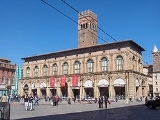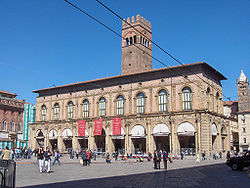
Palazzo del Podestà
Encyclopedia

Bologna
Bologna is the capital city of Emilia-Romagna, in the Po Valley of Northern Italy. The city lies between the Po River and the Apennine Mountains, more specifically, between the Reno River and the Savena River. Bologna is a lively and cosmopolitan Italian college city, with spectacular history,...
, northern Italy
Italy
Italy , officially the Italian Republic languages]] under the European Charter for Regional or Minority Languages. In each of these, Italy's official name is as follows:;;;;;;;;), is a unitary parliamentary republic in South-Central Europe. To the north it borders France, Switzerland, Austria and...
.
The edifice was built around 1200 as the seat of the local podestà
Podestà
Podestà is the name given to certain high officials in many Italian cities, since the later Middle Ages, mainly as Chief magistrate of a city state , but also as a local administrator, the representative of the Emperor.The term derives from the Latin word potestas, meaning power...
, the various functionaries of the commune. It stands on the Piazza Maggiore, near the Palazzo Communale and facing the Basilica of St. Petronio. Proving insufficient for the massive participation of the people in the city's government, it was in 1245 flanked by the Palazzo Re Enzo
Palazzo Re Enzo
Palazzo Re Enzo is a palace in Bologna, northern Italy. It takes its name from Enzio of Sardinia, Frederick II's son, who was prisoner here from 1249 until his death in 1272....
, over which stands the Torre dell'Arengo, whose bell was used to call the people during emergencies.
The Palazzo del Podestà is a long building, with a large hall on the upper floor.
The lower floor is a double open arcade, the so-called Voltone del Podestà, through which pass two lanes of shops.
In 1453 Aristotile Fioravanti
Aristotile Fioravanti
Ridolfo "Aristotele" Fioravanti was an Italian Renaissance architect and engineer. His surname is sometimes given as Fieraventi. Russian versions of his name are Фиораванти, Фьораванти, Фиеравенти, Фиораванте....
replaced the bell and reconstructed the original Gothic façade in the Renaissance style
Renaissance architecture
Renaissance architecture is the architecture of the period between the early 15th and early 17th centuries in different regions of Europe, demonstrating a conscious revival and development of certain elements of ancient Greek and Roman thought and material culture. Stylistically, Renaissance...
by order of Giovanni II Bentivoglio
Giovanni II Bentivoglio
Giovanni II Bentivoglio was an Italian nobleman who ruled as tyrant of Bologna from 1463 until 1506. He had no formal position, but held power as the city's "first citizen." The Bentivoglio family ruled over Bologna from 1443, and repeatedly attempted to consolidate their hold of the Signoria of...
. In the Voltone, in 1525, were placed the terracotta statues of the city's protectors, Sts. Petronius, Proculus, Dominic and Francis, all by Alfonso Lombardi
Alfonso Lombardi
Alfonso Lombardi , also known as Lombardi da Lucca, Alfonso da Ferrara and as Alfonso Lombardo, was an Italian sculptor and medalist who was born in Ferrara, Italy in 1497, and died in Bologna in 1537. He was very active in Bologna where he created a number of works that are still present in the...
.
In the 16th-18th centuries the Palazzo was used as theatre. In the 20th century it was frescoed by Adolfo de Carolis
Adolfo de Carolis
Adolfo de Carolis was an Italian painter, xylographer, illustrator and photographer who had a major importance in the Italian Liberty movement....
.

